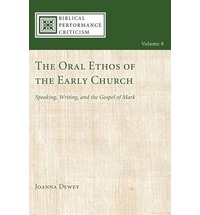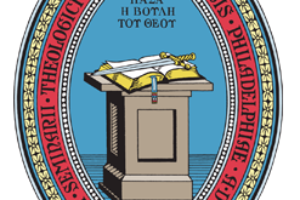Joanna Dewey’s recent volume, The Oral Ethos of the Early Church: Speaking, Writing, and the Gospel of Mark, represents one of the many important studies in Wipf and Stock’s recent series on Biblical Performance Criticism. For the sake of economy, I will not summarize every article collected in this volume; instead, I will summarize each of the book’s three sections. Finally, I will close with some brief reflections, which I hope that readers will take as merely the tip of the iceberg of what is an important, on-going conversation.
Dewey’s most significant argument of part one is that Christianity was primarily an oral culture for at least the first century of its existence (4). This would fit with the evidence she adduces from the wider culture. She argues that the function of writing in antiquity was primarily to exert power and status (6-7). Texts were deployed for propagandist purposes, and would be encountered through oral performances (8, 12). The diffusion of religious traditions was predominantly the work of unsanctioned, “popular” storytellers (12). Since these story tellers approached tradition from a vastly different social location than the elite, we can assume that they would “alter the stories to reflect popular values and popular resentments against the elite that they shared with their audience” (14).
With respect to Pauline churches, Dewey posits a Sitz in which letters were encountered through oral performance (19-20). In this scenario, a performer would have memorized the “base-text” of the letter in order to deliver it orally. While Paul is not to be envisioned as the architect of Christian textuality, his letters do end up serving as its foundation. Dewey sees evidence of this in what she determines to be an initial preference in churches for narrative “Pauls” (Acts, the pastorals, and the Acts of Paul and Thecla) over and against the Pauline letters: “Only as the more literate Christian leaders turned away from oral memory and oral authority to manuscripts, does the Paul of the letters begin to creep into Christian discourse” (25). This turn from orality to textuality means that the NT texts that we do have are “biased in favor of the views of those of higher social status, the only ones who were literate” (28).
Part two comprises a series of articles written on the Gospel of Mark. The first two articles, “The Literary Structure of the Controversy Stories in Mark 2:1-3:6” (53-62) and “Mark as Interwoven Tapestry” (63-78), represent two of Dewey’s more widely cited works. In the former, she makes a cogent case that the first controversy section (Mark 2:1-3:6) is a carefully crafted chiasm, with the crucifixion-resurrection at the center (Mark 2:20). In the latter, she posits an alternative theory to the multifarious attempts at reading Mark as a linear plot.
An oral ethos also has important implications for how Mark’s central themes should be interpreted. If oral cultures tell stories that are “additive and aggregative,” then it makes little sense to posit a theological conflict between the two halves of Mark (97-8). The cross is added onto the miracles of power rather than pitted against them. Further, because oral cultures expected stories to be agonistic in tone, Dewey finds it improbable that audiences would have seen the disciples in a negative light (98-100). Indeed, she argues that “identification” with the characters of the narrative was at the very center of oral performance (102).
In the final section of the book, Dewey offers the readers several “wider implications” for NT studies. Chapters 8-9 (131-156) focus on the role of women storytellers in early Christian communities. Dewey’s central point is that “[i]t matters who tells the stories” (131, italics mine). For Dewey, “[a]s long as Christianity remained orally based,” women maintained their status as equal participants in the shaping of Jesus traditions (139). The shift to writing simultaneously marked a shift to censorship and male domination: “As men wrote the gospels, they selected, modified, and created material to include or omit. They tended to select the men’s stories…” (143). Chapter 10 argues that the best explanation for the survival of Mark is that “it was a good story, easily learned from hearing…and performed, [and] thus easily transmitted orally” (158). Dewey argues that, ironically, it was the collection of written texts that spelled the demise of Mark’s popularity among the early church (169). The final chapter picks up on and expands a theme suggested throughout the book. That is, there was no such thing as a stable “Mark” among first century churches. Audiences would have heard a plurality of “Marks,” and the text that we do have “does not represent the original text” (175).
As this summary elucidates, the issues that Dewey addresses have major implications for NT interpretation. The “big issues” that this volume raises are perhaps best articulated in a series of questions: 1. Can we (contemporary readers) trust the text we actually have? Or, should we reconstruct a “better” rendition of the text? 2. In what sense (if at all) should the Mark that we have be considered “authoritative” if it is just one of a myriad of “Marks?” 3. What constitutes (and who adjudicates) what is and is not a faithful rendition of “Mark?” For example, if Dewey is correct, that behind Mark’s androcentric rendition existed numerous egalitarian renditions of the Gospel, then we might conclude that the text we have is woefully inferior. Aside from these broad questions, Dewey makes several moves that, in my opinion, warrant critical scrutiny. To cite but one example, her use of D.C. Parker’s work (e.g. 174-5) pushes the evidence—and, indeed, Parker’s argument—beyond what is defensible. The type of textual variation Parker points to in his study is nowhere near as vast as the type of variation suggested by Dewey. The analogy between recent text-critical studies and the type of variations one would expect in oral performance is not as strong as Dewey suggests.
The Bottom Line: This volume comprises a collection of articles written by one of the preeminent Markan scholars of our day. Dewey’s synthesis of NT studies, orality studies, and feminist interpretation is sure to provide every reader with much to ponder. This book is absolutely essential reading.
Reviewed by Max A. Botner (mb274@st-andrews.ac.uk)
University of St Andrews





Leave a Reply
Your email is safe with us.